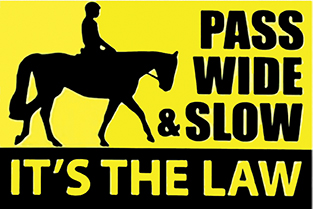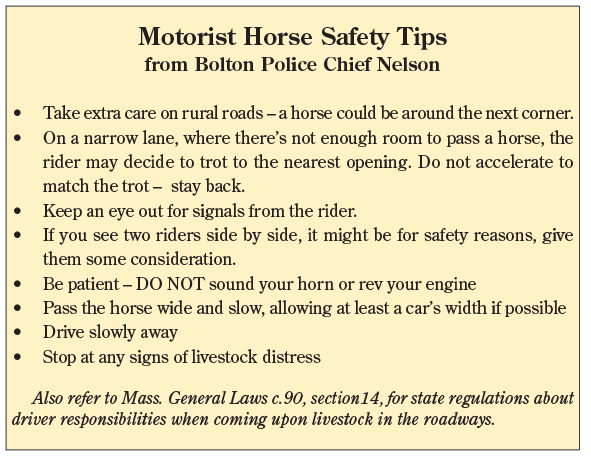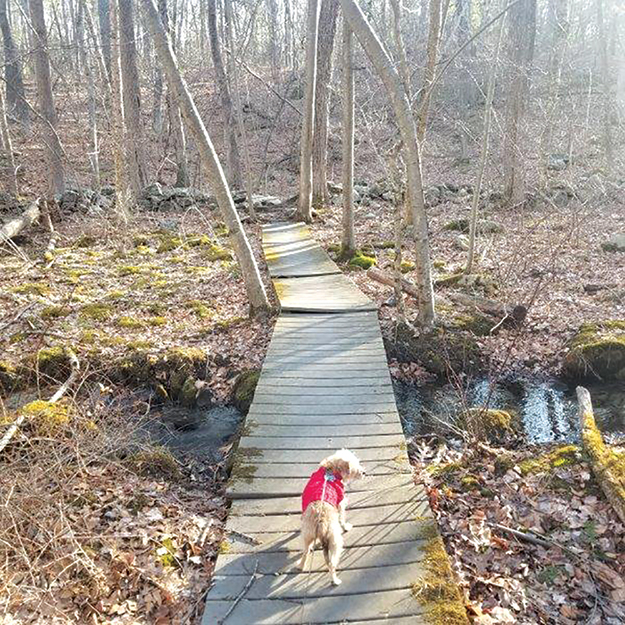
Published in the April 21, 2021 Stow and Bolton Independent
See related article “Horses in Bolton: Beyond Road Safety”
By Maura Rousseau Sieller
Do you know what you’re supposed to do when you see someone on horseback riding along the road? A wave, a honk, or speeding up to get out of the way may seem harmless, but you could be putting yourself, the horse, and the rider in danger.
“People here are great. They don’t want anyone to get hurt,” said Bolton’s Cindy Ayotte, founder of the Bolton Horse Safety Improvement Initiative. “They just don’t know what to do,” she said of many people when encountering a horse and rider on the road or on the trails.
The goals of the Bolton Horse Safety Improvement Initiative include educating the public about horse safety, increasing horse mobility on trails within the town, and improving road safety by installing signs at strategically placed points.
Ayotte, whose own horse weighs around 1,000 pounds, cautioned that safety measures aren’t just in place for the horse and the rider, but also for the driver. “Motorists should always assume the horse is going to spook,” she said. “Even if you have a horse who is very calm and who normally doesn’t spook, it could be the one day that a breeze blows the wrong way and the horse goes into the road.”
Police Chief Warren Nelson offered some advice for drivers in order to avoid an accident when encountering horses on Bolton’s roadways. “Motorists frightening livestock can be a dangerous encounter for the rider, the motorist, and general public,” he said. “Whenever you come upon a situation like this from the opposite direction, you should first slow down and be prepared to bring your vehicle to a complete stop. This will give the livestock time to process your presence and the rider will have time to evaluate how the animal is reacting. Make eye contact with the person in charge of the livestock, so that they are aware you are there.”
Even a friendly honk can be very startling for an animal. “Don’t honk your horn to get their attention–sit and wait patiently,” Nelson said. “The majority of the people leading livestock are very familiar with using the public ways and will communicate some sort of a hand gesture telling you what to do.”
One of the ways to best maintain the safety of horses as they amble through Bolton is by keeping horses off the roads and on conservation trails. One challenge to riders who use these trails are bridges, which need to be maintained and designed in a certain way for the horse and rider to safely cross.
Ayotte explained that riders often prefer not to be on the roads, but trail accessibility has become an issue. “Due to nobody’s fault, the accessibility on the trails has diminished. I don’t want to trash the bridges, because it was a lot of work for the people to bring those materials in there. But we can’t get past those bridges that are there.”
Part of the Horse Safety Initiative’s efforts has been to document the various bridges across Bolton that are currently unsafe for horses to cross. Ayotte hopes to present a plan to Bolton’s Conservation Commission to fix, build, and fund the construction of new bridges. “I think they’re very open to what we are doing, but we need to be able to provide them with a solution,” she said.
The group would welcome additional volunteers, especially someone with expertise to serve on the bridge subcommittee. For more information, contact Cindy Ayotte at [email protected] or 978-621-2742.

